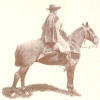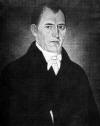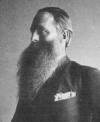
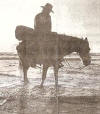
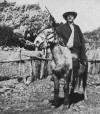
Scottish Long Rider George Patterson was a Founding Member of the Long Riders’ Guild who journeyed into remote Tibet at the conclusion of the Second World War. There he not only underwent a great spiritual awakening, George also became involved with the Tibetan resistance to the invading Chinese Communist army.
The tale of George's travels, first across war-ravaged China and then into the mysterious mountain kingdom of Tibet, is a moving account alternately full of spiritual insight and hair-raising adventure.
Having gone to the remote country in 1947, the young Scotsman began living and riding with the mounted Khamba tribesmen. After two years, Patterson had mastered the language and local customs, the result being that the resilient Long Rider had become nearly Tibetan himself. Then in 1949 word came that the Chinese Communists were preparing to invade Patterson's adopted homeland. In desperate need of military aid and international protection, Tibetan leaders asked Patterson to make a perilous winter-time horse ride over the Himalayas into neighbouring India.
The mission was tantamount to suicide. But if George had one thing on his side, it was unwavering faith that God had sent him to Tibet for a purpose. With that conviction lodged firmly in his heart, he saddled up his horse, "who was built like a song and moved like a melody", then set off into a winter wasteland. The subsequent equestrian journey through the snow-covered Himalayas nearly slew the valiant Scotsman and his intrepid Tibetan companions.
"We had to deal with blizzards that came virtually every day," he said. "I slept with the horses some of the time; I even slept with a yak just to get the body heat because it was biting cold. The Tibetans didn't use tents, so it was easier to go with what they were used to. They used to find dung from previous travelling parties and set it alight using sparks from their matchlock guns."
The extraordinary equestrian journey took George from Tatsienlu, Tibet to Dibrugarh in the Naga Tribe territory of Northern India. After delivering the Tibetan’s plea, George wrote Journey with Loshay about his ride across the Himalayas.
The journey also earned George the undying enmity of the Chinese communist government. The enraged Chinese authorities issued orders to have Patterson liquidated, a death sentence which was never rescinded.
Years later, with the Red Chinese still occupying Tibet, and with a bounty on his head for his role in rescuing the Dalai Lama, a band of determined Tibetan guerrillas invited Patterson to witness their attack on the invading Communist army. No other westerner could get into Tibet, except Patterson, so the outside world was still oblivious to the Chinese invasion and the atrocities being perpetrated on the Tibetans. So Patterson went back into his adopted country – illegally – and with a film crew. Upon his return, George wrote Gods and Guerrillas.
Hailed as “Patterson of Tibet,” George continued to write and lectured at Cambridge about his travels. He wrote, “My own final contribution to the people of Tibet, in the absence of any effective action by mealy-mouthed politicians across the globe, as I approach the age of ninety as the oldest living Long Rider and former champion of Tibet, is to call on all living past and present explorers, mountaineers, and lovers of political freedom everywhere, to join in a united protest on behalf of the people of Tibet against this vicious and immoral regime in China.”
In recognition of how George battled for Tibet’s freedom for more than sixty years, His Holiness the Dalai Lama authorized the Light of Truth Award to be bestowed on Patterson in 2010 by officials of the International Campaign for Tibet. This honour is reserved for individuals who have made significant contributions to the fight for human rights and democracy for the Tibetan people.
Though he was a fearless political campaigner, George was also a passionate Long Rider. He attended the international meeting of equestrian explorers which was held at the Royal Geographical Society in London in 2005. His journey is featured in a special study entitled Long Riders on the Roof of the World. And his “Story from the Road” entitled To Save a Country details his equestrian journey. Though his health was failing in 2012, George published a final appeal for a free Tibet. The Guild maintains a special page containing news stories about George’s remarkable life.
Before his death in 2013, the Long Rider, spiritual leader and political crusader wrote, “It would be a mistake to believe The Long Riders’ Guild is simply an equestrian travel organization. Under the direction of Basha and CuChullaine O’Reilly the Guild has grown to be a renowned defender of equestrian ethics and a champion of social justice. The Guild’s mission is to protect horses, to educate and encourage those seeking wisdom, and when necessity demands, to speak the truth to those who would abuse their power.”
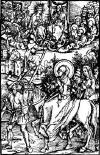
Dmitri Peshkov - in November 1889 Peshkov left his garrison's faraway outpost of Blagoveshchensk in the far east of the Russian Empire on his Siberian horse, Seriy. After many amazing adventures, they arrived in St. Petersburg at the Tsar’s court having covered more than 5,500 miles – in temperatures sometimes as low as -60 degrees Fahrenheit. Peshkov is considered the father of modern equestrian travel, as his influence spread far and wide. The story of the Cossack Long Rider’s journey from Siberia to St. Petersburg inspired Jean-Louis Gouraud, one Guild’s Founding Members, to write a book about Peshkov. That book was later made into the first Long Rider movie.
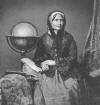
Ida Pfeiffer - If England is rightly proud of the doughty Long Rider Isabella Bird, the German-speaking world can take equal delight in recalling the mounted adventures of its own intrepid lady Long Rider, the brave Ida Pfeiffer.
Ida was born in Vienna, Austria, in 1797 and, thanks to an indulgent father, was encouraged to follow her tomboyish tendencies. This instilling of courageous behaviour at such a young age led to Ida becoming a determined, brave and outspoken young woman. After the death of her father, Ida reluctantly married a man several years older than she was. Yet though they had two sons, Ida laboured under the constraints placed upon her by conventional society. Therefore, after her husband died, and as soon as her sons had homes of their own, the still-young Ida set off from home anxious to fulfil one desire: to explore the world at last!
Ida's travels took her to many of the most exotic parts of the planet, including Scandinavia, South America, the South Pacific, China, India, Persia, Asia Minor, Europe and North Africa. It was, however, her equestrian journey across Iceland in 1845 which marks Ida as an Historical Long Rider. During that journey the observant traveller described the island kingdom as "a whole world of glaciers, lava-peaks, fields of snow and ice, rivers and miniature lakes." Her equestrian journey allowed her to visit the locals, witness the geysers, climb to the top of volcanoes and observe the interesting local customs. These included "passionate addictions to brandy-drinking, snuff-taking and tobacco-chewing," but not, she noted, any strong desire for excess work. By 1856 Ida's travel books had been translated into seven languages, she had seen a great deal of the world and survived a host of dangerous adventures. With those qualifications in mind, the diminutive Long Rider ventured to London. Her goal was to meet England's most celebrated explorer, Richard Francis Burton, and convince him to allow her to accompany him on his forthcoming journey to find the source of the Nile River. Despite having entered into Mecca in disguise, the flamboyant Burton wasn't able to evade the persistent Pfeiffer, who methodically peppered him with requests.
Despite her excellent travel qualifications, and disregarding her documented courage, the normally unorthodox Burton sided with the patriotic forces of conventional society. As history later revealed, this was one of the most remarkable "what if?" moments in exploration history. What if these two incredible Historical Long Riders had defied custom and ignored the allure of patriotism by creating an International Expedition?
Instead of travelling with Pfeiffer, the widely-travelled and talented linguist, Burton chose John Hanning Speke. Speke was not well-travelled and no linguist, and is the man whom history as often defined as an infamous cad and who later betrayed Burton's trust in an act of notorious self-interest.
When her hopes were dashed by Burton, Pfeiffer responded in her usual resolute manner by announcing that if Captain Burton would not allow her to accompany him into the interior of the Dark Continent, then she would venture into another area of that world alone. Soon afterwards, the intrepid Ida set off to document the secrets of Madagascar. There she became afflicted with a series of fevers which eventually slew her.
Despite the years she had spent in domestic duty, Ida Pfeiffer never lost sight of her dream for adventure. During her lifetime she was awarded membership into the geographical societies of both Germany and France. Sadly, the Royal Geographical Society of England denied her that honour due to her sex. Today Ida's legacy lives on by providing us with the memory of a woman of matchless intrepidity, surprising energy and heroic fixity of purpose.
In 1925 the Argentine Long Rider Abelardo Piovano rode his Criollo, Lunarejo Cardal, from Buenos Aires, Argentina to Mendoza, Chile in only seventeen days. This rare photo shows the equestrian traveller, and his fourteen-year-old horse, ten days after they made their record journey.
Roger Pocock’s life reads like a fairytale full of adventure. A childhood cut short to go to sea, then service with the Canadian North West Mounted Police in 1885, followed by stints as a war correspondent, Yukon gold miner, South African army scout, and “missionary to hostile tribes.” In between he formed the Legion of Frontiersmen, organized the original World Flight by airplane and was the first person in history to ride the length of the infamous Outlaw Trail.
Pocock departed from Ford McLeod in Canada in 1899. Despite being unarmed, he sought out and met Butch Cassidy and other notorious outlaws at Hole-in-the-Wall, Jackson's Hole and Robbers Roost. After riding 3,600 miles, he reached Mexico City in 1900. During the course of the solo ride Pocock filed a series of articles for an English newspaper. Those rare articles, reprinted by the Guild for the first time in more than a century, make up a remarkable “Story from the Road” entitled Riding the Outlaw Trail.
But the ride from Canada to Mexico did not mark the end of Pocock’s adventures.
Following the Frontier is considered his best work describing as it does his early adventures in North America. Although the autobiographical account reads like fiction, it is in fact only the first half of his remarkable life. Pocock begins his tale by explaining how he came to join the Canadian Mounties in 1885. When the Saskatchewan Rebellion broke out soon afterwards, Pocock’s unit was ordered to march from Regina to Fort Albert during the height of the Canadian winter. The author’s feet were severely frost-bitten, leaving him crippled for life. Never one to be put off by physical adversity, Pocock went on to become one of the nineteenth century’s most influential equestrian travellers. One of the highlights of Following the Frontier are the various accounts of how the unarmed Pocock spent many a night with the hunted American outlaws then inhabiting this lawless section of the Old American West.
When he was wasn’t seeking excitement, Pocock could be found writing. Though most of the prolific author’s work predictably revolved around the exciting episodes of his own life, or the other men of action he knew, Pocock’s most well-known foray into academic study was his rightfully famous book, Horses. In today’s equine-friendly world it is difficult to imagine how revolutionary Pocock’s observations about horses were at the time. Horses was penned by Pocock while he was serving with the British army, stationed behind the trenches during the First World War.
.
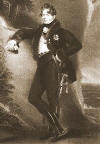
Sir Robert Ker Porter was a celebrated English artist and
explorer who travelled to Spain, Portugal, Russia, Finland, Sweden and South
America. In addition to being knighted by Great Britain’s Prince Regent and
the King of Sweden, Sir Robert was awarded the order of the Lion and the Sun
by the Shah of Persia.
His most celebrated equestrian journey began in 1817 when he set off to ride from St. Petersburg, Russia to Teheran, Persia. After his arrival in the Shah’s kingdom, Sir Robert explored the ancient ruins of Persepolis and is credited with being the person who located the mausoleum of the legendary Persian monarch, Cyrus the Great. Sir Robert’s book, Travels in Georgia, Persia, Armenia, Ancient Babylonia recounted his adventures riding through the dangerous Caucasus mountains.
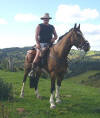
Diana Pullein-Thompson was the daughter of Joanna Cannan, a prolific novelist who is credited with inventing pony stories for children, beginning with “A Pony for Jean” (1936). Diana was nine when her story, “The Life of a Carthorse”, appeared in a magazine. She wrote her first book, “I Wanted a Pony”, at the age of 14. Along with her sisters, Josephine and Christine, the Pullein-Thompson sisters wrote more than 150 books that were populated by unforgettable equine characters and the children who loved and rode them.
A founder member of the Children’s Writers Group of Great Britain’s Society of Authors, Diana’s 30 equestrian novels rejected the prevailing concept that horses were reserved for the rich. In 1996 the fearless rider, who broke and schooled horses, based her last book, “The Long Ride Home” on the journey she made with her grey mare, Favorita, from John O’Groats, Scotland to Land’s End, Cornwall in 1956.
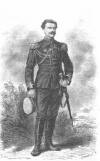
Though remembered today more for his work as a pioneering geologist, Raphael Pumpelly also undertook several equestrian journeys during the course of his long academic career.
After having graduated from the Royal School of Mines in Germany, the young American’s first assignment in 1859 was to oversee the development of silver mines in the Apache held portion of the Arizona territory. This mission found him making perilous rides through mountains, often times barely escaping death. In a bold move, in 1861 he next accepted an offer to work as a consulting geologist for the Emperor of Japan. Once again he explored the countryside during extended rides. He thereafter journeyed to China, and then made an equestrian journey to St. Petersburg, Russia.
Though he returned to the United States and enjoyed a brilliant academic career, Pumpelly still longed for adventure.
During his 1903 expedition through Turkestan, he sought
evidence of the Usun, a people of antiquity who were rumoured to have had
red hair and blue eyes. The discovery of the “Tarim Mummies,” by subsequent
scientists confirmed the existence of the forgotten people.
Here is a link to his Story from the Road.
